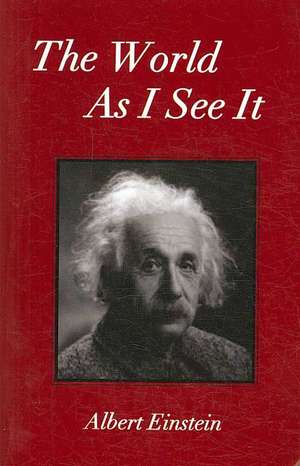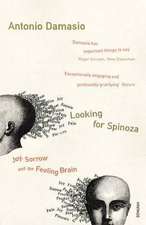The World as I See It
Autor Albert Einsteinen Limba Engleză Paperback – 28 feb 2007
| Toate formatele și edițiile | Preț | Express |
|---|---|---|
| Paperback (4) | 60.19 lei 22-36 zile | |
| www.bnpublishing.com – 16 iul 2007 | 60.19 lei 22-36 zile | |
| Book Tree – 28 feb 2007 | 68.83 lei 22-36 zile | |
| Philosophical Library/Open Road – 19 oct 2015 | 102.56 lei 22-36 zile | |
| General Press – 2018 | 86.92 lei 43-57 zile | |
| Hardback (3) | 109.86 lei 22-36 zile | |
| www.bnpublishing.com – 4 mai 2007 | 109.86 lei 22-36 zile | |
| BOOK TREE – 14 mar 2007 | 151.06 lei 22-36 zile | |
| General Press – 2018 | 166.93 lei 43-57 zile |
Preț: 68.83 lei
Nou
Puncte Express: 103
Preț estimativ în valută:
13.17€ • 13.79$ • 10.90£
13.17€ • 13.79$ • 10.90£
Carte disponibilă
Livrare economică 17-31 martie
Preluare comenzi: 021 569.72.76
Specificații
ISBN-13: 9781585092871
ISBN-10: 1585092878
Pagini: 128
Dimensiuni: 141 x 216 x 8 mm
Greutate: 0.16 kg
Editura: Book Tree
Locul publicării:United States
ISBN-10: 1585092878
Pagini: 128
Dimensiuni: 141 x 216 x 8 mm
Greutate: 0.16 kg
Editura: Book Tree
Locul publicării:United States
Notă biografică
Albert Einstein (14 March 1879 - 18 April 1955) was a German-born theoretical physicist[5] who developed the theory of relativity, one of the two pillars of modern physics (alongside quantum mechanics).[3][6]:274 His work is also known for its influence on the philosophy of science.[7][8] He is best known to the general public for his mass-energy equivalence formula E = mc2, which has been dubbed "the world's most famous equation".[9] He received the 1921 Nobel Prize in Physics "for his services to theoretical physics, and especially for his discovery of the law of the photoelectric effect",[10] a pivotal step in the development of quantum theory. The son of a salesman who later operated an electrochemical factory, Einstein was born in the German Empire but moved to Switzerland in 1895 and renounced his German citizenship in 1896.[5] Specializing in physics and mathematics, he received his academic teaching diploma from the Swiss Federal Polytechnic School (German: eidgenössische polytechnische Schule, later ETH) in Zürich in 1900. The following year, he acquired Swiss citizenship, which he kept for his entire life. After initially struggling to find work, from 1902 to 1909 he was employed as a patent examiner at the Swiss Patent Office in Bern. Near the beginning of his career, Einstein thought that Newtonian mechanics was no longer enough to reconcile the laws of classical mechanics with the laws of the electromagnetic field. This led him to develop his special theory of relativity during his time at the Swiss Patent Office. In 1905, called his annus mirabilis (miracle year), he published four groundbreaking papers, which attracted the attention of the academic world; the first outlined the theory of the photoelectric effect, the second paper explained Brownian motion, the third paper introduced special relativity, and the fourth mass-energy equivalence. That year, at the age of 26, he was awarded a PhD by the University of Zurich. Although initially treated with skepticism from many in the scientific community, Einstein's works gradually came to be recognised as significant advancements. He was invited to teach theoretical physics at the University of Bern in 1908 and the following year moved to the University of Zurich, then in 1911 to Charles University in Prague before returning to the Federal Polytechnic School in Zürich in 1912. In 1914, he was elected to the Prussian Academy of Sciences in Berlin, where he remained for 19 years. Soon after publishing his work on special relativity, Einstein began working to extend the theory to gravitational fields; he then published a paper on general relativity in 1916, introducing his theory of gravitation. He continued to deal with problems of statistical mechanics and quantum theory, which led to his explanations of particle theory and the motion of molecules. He also investigated the thermal properties of light and the quantum theory of radiation, the basis of laser, which laid the foundation of the photon theory of light. In 1917, he applied the general theory of relativity to model the structure of the universe











